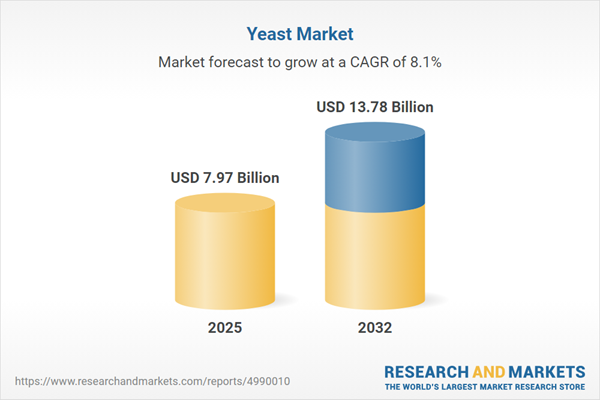Speak directly to the analyst to clarify any post sales queries you may have.
Senior decision-makers are navigating a period of rapid change in the yeast market, where innovative solutions and strategic agility are central for sustaining growth and competitive advantage. As industry complexity increases, actionable insights and adaptable frameworks have become essential tools for driving organizational performance and successfully managing market uncertainty.
Market Snapshot: Global Yeast Market Growth and Opportunity
The global yeast market achieved a value of USD 7.38 billion in 2024 and is projected to reach USD 7.97 billion by 2025, with a projected compound annual growth rate of 8.11% through 2032. This upward trajectory is supported by accelerating demand across food processing, industrial manufacturing, and pharmaceutical industries. Companies are channeling investment into research, product innovation, and digital transformation to enhance their position. New yeast-based products and smarter manufacturing techniques are aligning enterprises with growing consumer expectations and evolving regulatory demands, highlighting the need for ongoing adaptability in the sector. Senior leaders now prioritize robust technological readiness and regulatory alignment to maintain long-term relevance.
Scope & Segmentation: Comprehensive Coverage of the Yeast Market
- End Use: The analysis includes animal feed solutions focusing on aquaculture, poultry health, and ruminant wellbeing; baking yeast for both large-scale operations and home use; applications in bioethanol production; versatile brewing strains for diverse alcoholic beverages; nutraceutical products emphasizing probiotics; and personal care yeast, including cosmetics and skincare applications. Advanced pharmaceutical use is covered, considering technical and quality requirements.
- Type: Market assessment addresses the principal yeast forms: active dry, fresh, and instant. Each type is evaluated for performance suitability in food, animal nutrition, and industrial settings.
- Form: Examination of granulated, powdered, and liquid forms such as creams and suspensions, focusing on how each targets specific processing, shelf-life, and efficiency needs in varying production setups.
- Distribution Channel: Offline and online sales channels are evaluated for their roles in sourcing efficiency, supply chain flexibility, and scalability, with attention to operational resilience amid rapidly shifting market environments.
- Region: Regional insights span the Americas, Europe, Middle East, Africa, and Asia-Pacific. Each region’s unique consumption patterns, regulatory environments, and economic variables are explored to highlight the importance of localized strategies, especially for China, India, and Japan.
- Key Companies: The report profiles industry leaders such as Lesaffre S.A., Lallemand Inc., Angel Yeast Co., Ltd., Associated British Foods plc, Alltech, Inc., International Flavors & Fragrances Inc., DSM-Firmenich, Chr. Hansen Holding A/S, Kerry Group plc, and Archer Daniels Midland Company. Analysts evaluate how these firms are advancing digitalization, global logistics, and targeted product development to improve market positioning.
Key Takeaways: Strategic Insights for Senior Decision-Makers
- Investment in yeast strain engineering and advanced processing enables firms to deliver customized products optimized for an expanding range of industry applications, from food security to biomanufacturing.
- Focus on sustainable sourcing and transparent procurement practices strengthens supplier relationships while ensuring compliance with evolving regulatory standards in multiple regions.
- Adoption of digital monitoring solutions and laboratory automation improves quality control, streamlines workflow, and enhances customer outcomes by minimizing inconsistencies in production.
- Ongoing complexity in global regulatory frameworks is pushing organizations to adopt comprehensive quality management and stay ready for new developments, especially in functional ingredients and health-oriented markets.
- Collaboration between industry and academia is accelerating innovation, helping companies respond to emerging consumer and regulatory needs with precision and speed.
- Regional customization of market and operational strategies is key as firms respond to local trends, shifting legislation, and customer expectations to protect and grow market share.
Tariff Impact: Navigating Trade Policy and Supply Chain Change
Recent U.S. tariffs on key yeast raw materials have compelled global producers to strengthen sourcing strategies and enhance risk management. Companies are increasingly prioritizing regional manufacturing, building robust local partnerships, and developing business continuity plans. These actions help ensure long-term resilience and stable client relationships in the face of ongoing trade policy changes, enabling organizations to mitigate disruption and maintain supply chain integrity.
Methodology & Data Sources
The report is informed by in-depth engagement with industry experts, comprehensive reviews of technical and patent literature, and company disclosures. Scenario analysis and rigorous cross-validation support the reliability of findings, ensuring an accurate assessment of technological development, regulatory movements, and business strategy in the yeast sector.
Why This Report Matters: Strategic and Tactical Value in the Yeast Market
- Provides senior teams with data-driven guidance for expansion, market entry, and positioning strategies in the yeast industry.
- Helps procurement and R&D leaders to pinpoint growth regions and implement operational best practices for optimizing resource allocation.
- Offers frameworks for building resilient supply chains that adapt to new technologies, policy shifts, and shifting customer demands.
Conclusion
This report delivers the comprehensive intelligence required for senior leaders to address industry transformation, manage emerging risks, and enhance organizational resilience across the global yeast value chain.
Additional Product Information:
- Purchase of this report includes 1 year online access with quarterly updates.
- This report can be updated on request. Please contact our Customer Experience team using the Ask a Question widget on our website.
Table of Contents
3. Executive Summary
4. Market Overview
7. Cumulative Impact of Artificial Intelligence 2025
Companies Mentioned
The companies profiled in this Yeast market report include:- Lesaffre S.A.
- Lallemand Inc.
- Angel Yeast Co., Ltd.
- Associated British Foods plc
- Alltech, Inc.
- International Flavors & Fragrances Inc.
- DSM-Firmenich
- Chr. Hansen Holding A/S
- Kerry Group plc
- Archer Daniels Midland Company
Table Information
| Report Attribute | Details |
|---|---|
| No. of Pages | 182 |
| Published | October 2025 |
| Forecast Period | 2025 - 2032 |
| Estimated Market Value ( USD | $ 7.97 Billion |
| Forecasted Market Value ( USD | $ 13.78 Billion |
| Compound Annual Growth Rate | 8.1% |
| Regions Covered | Global |
| No. of Companies Mentioned | 11 |









